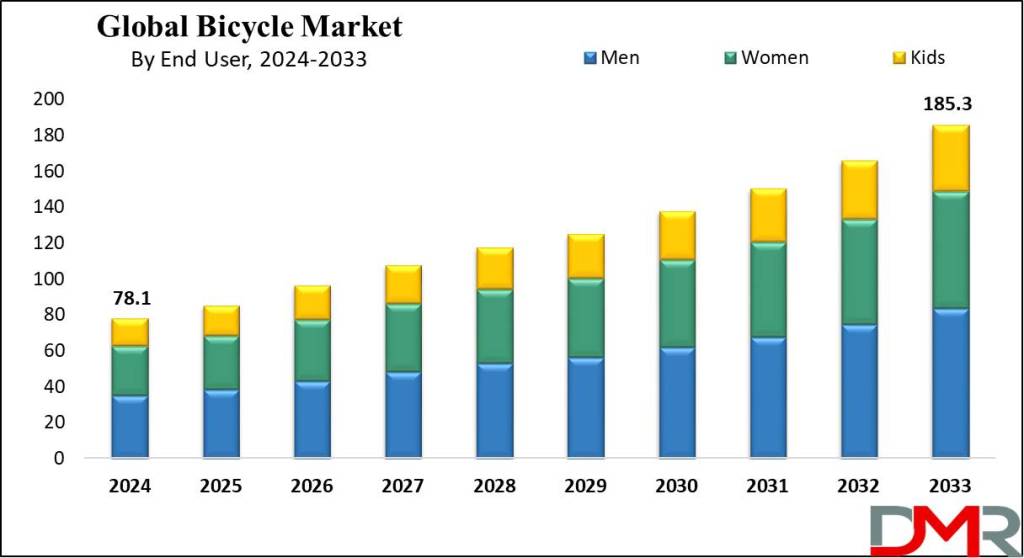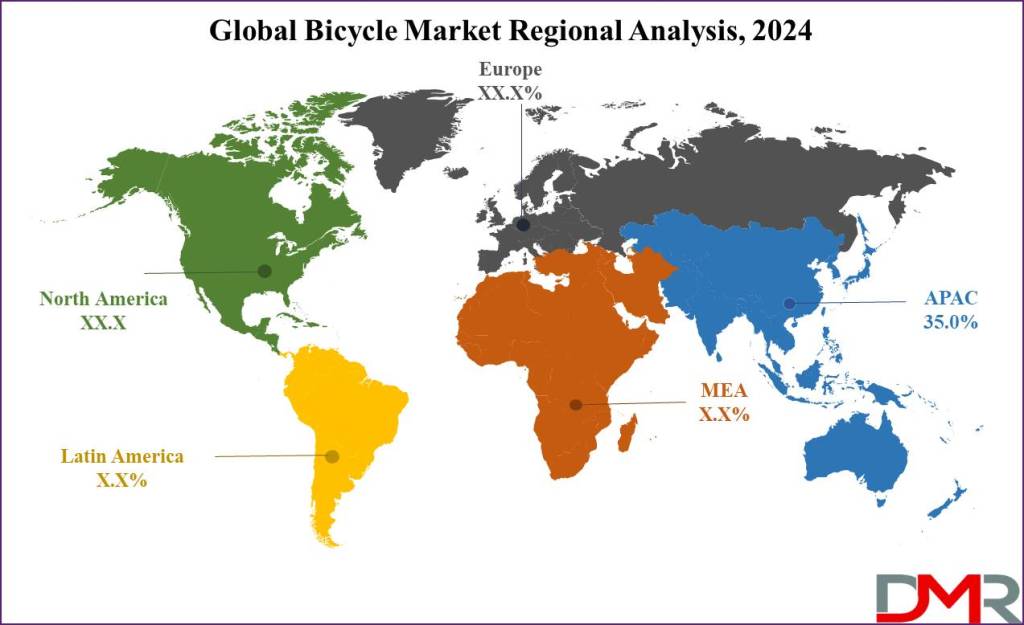Market Overview
The Global Bicycle Market is witnessing significant growth, projected to reach a valuation of USD 78.1 billion in 2024 and is expected to soar to USD 185.3 billion by 2033, boasting a Compound Annual Growth Rate (CAGR) of 10.1%. This exponential growth is attributed to various factors such as production, distribution, and sales initiatives within the industry.
Bicycles, essentially vehicles with two wheels propelled by pedaling, cater to diverse needs including commuting, recreation, sport, and transportation. They come in various types such as road, mountain, hybrid, and electric bikes, each serving specific purposes. The distribution channels for bicycles encompass shops, online retailers, department stores, and sporting goods outlets. The market's upward trajectory is propelled by the burgeoning interest in sustainable transportation options and the increasing awareness regarding the health and fitness benefits associated with cycling.

Bicycle Market Growth Analysis
Key Takeaways
- Projected Growth: The global bicycle market is expected to reach USD 78.1 billion in 2024 and is projected to attain USD 185.3 billion by 2033, registering a CAGR of 10.1%.
- Segment Dominance: Road bicycles are poised to dominate the market with a revenue share of 41.5% in 2024.
- Design Preference: The regular segment is anticipated to command the market in 2024, owing to its efficiency and widespread availability.
- Technological Trends: Conventional bicycles are expected to lead the market in 2024, accounting for 84.2% of the revenue share.
- Demographic Dynamics: Men's segment is projected to dominate the market in 2024 with a revenue share of 44.9%.
- Distribution Channels: The offline distribution channel is predicted to hold the majority share of 52.3% in 2024.
Use Cases
- Eco-friendly Commuting: Bicycles offer a sustainable and cost-effective alternative for short to medium distance commuting.
- Recreational Riding: Cycling provides a serene way to enjoy nature, whether in parks, countryside, or urban environments.
- Fitness and Health: Cycling serves as a form of cardiovascular exercise, contributing to improved fitness levels.
- Environmental Sustainability: With the aim of reducing carbon emissions and air pollution, bicycles emerge as environmentally sustainable modes of transportation.
- Adventure Commuting: Cycling facilitates adventurous commuting, allowing individuals to explore new places at a leisurely pace.
Get a Free PDF Sample Copy Here@ https://dimensionmarketresearch.com/report/bicycle-market/request-sample/
Key Factors
- Urbanization and congestion challenges drive demand for bicycles as a sustainable commuting option.
- Technological advancements in electric bicycles enhance convenience and appeal to a wider consumer base.
- Infrastructure development plays a crucial role in supporting bicycle commutation initiatives.
- Consumer awareness regarding health and fitness benefits fuels the demand for bicycles.
- Demographic shifts, particularly increased female participation, shape market dynamics.
- Competitive pricing and availability of bicycles influence consumer purchasing decisions.
- Environmental concerns and initiatives promote the adoption of eco-friendly transportation options.
- Regulatory support and policies promoting bicycle-friendly cities contribute to market growth.
Targeted Audience
- Bicycle Manufacturers
- Retailers and Distributors
- Investors and Financial Institutions
- Policymakers and Urban Planners
- Fitness Enthusiasts and Athletes
- Environmental Organizations and Advocates
- Transportation Authorities
- Educational Institutions and Research Organizations
Market Dynamics
The bicycle market's growth trajectory is primarily fueled by urban challenges such as limited parking space and traffic congestion, prompting individuals to opt for bicycles for short-distance travels. Furthermore, the popularity of bicycle events and the burgeoning fitness market contribute to increased sales of mountain and road bikes. However, challenges persist, such as inadequate infrastructure in developing economies like India hindering market growth, and the high cost associated with lightweight bicycles acting as a barrier to market expansion.
Research Scope and Analysis
By Product
Road Bicycles
The dominance of road bicycles is attributed to their simplicity and versatility, making them ideal for various purposes including commuting and recreational riding. Customized bikes tailored for specific functions are gaining traction among consumers, further bolstering this segment's growth.
Mountain Bikes
The growing popularity of adventure sports among millennials fuels the growth of the mountain bike industry.
Cargo Bikes
Cargo bikes emerge as the fastest-growing segment, driven by the trend of replacing motorized transport for short-distance commercial applications.
By Design
Regular Bikes
Regular bikes witness widespread adoption owing to their efficiency, affordability, and ease of availability.
Folding Bikes
Folding bikes are gaining traction, particularly in urban environments with limited storage space, owing to their compact design and portability.
By Technology
Conventional Bikes
Conventional bicycles lead the market due to lower maintenance costs and convenience. They continue to appeal to a wide consumer base, particularly women.
Electric Bikes
Electric bicycles exhibit rapid growth, offering easy operation and faster travel times. Their convenience and maintenance-free batteries attract consumers seeking enhanced commuting options.
By End User
Men
Men continue to dominate the bicycle market, albeit efforts to simplify cycling mechanisms aim to attract more women to the market for recreational and fitness purposes.
Women
With advancements in bicycle technology and the introduction of adaptable gear systems, the market is witnessing increased participation of women in cycling activities.
Kids
Bicycles designed for children prioritize safety and learning, featuring adjustable components to accommodate children's smaller bodies and developing motor skills.
By Distribution Channel
Offline
The offline distribution channel retains its dominance, offering personalized buying experiences and immediate product availability, thereby catering to a large consumer base.
Online
The online distribution channel experiences rapid growth, driven by increasing smartphone and internet penetration. Online retailers offer discounts and a wide range of options, further boosting market growth.
Buy This Premium Report Here@ https://dimensionmarketresearch.com/checkout/bicycle-market/
Regional Analysis
Asia Pacific
Asia Pacific emerges as the dominant region for the bicycle market, fueled by infrastructural developments and active investment in bicycle-friendly commute initiatives. Countries like China and Japan spearhead this growth trajectory.

Europe
Europe secures a substantial market share, with bike-friendly cities and investments in infrastructure supporting bicycle commutation. Nations like Belgium, Denmark, France, and Italy drive market growth through ongoing infrastructure developments.
Competitive Landscape
The bicycle market is fiercely competitive, with major players such as Giant Manufacturing Co. Ltd, Accell Group, Trek Bicycle Corporation, and Merida Industry Co. Ltd vying for market dominance. These industry giants employ strategies like innovation, partnerships, and mergers to expand their global footprint.
Recent Developments
- Merida Industry Co., Ltd: Introduced the latest model of its Silex gravel bike, designed to enhance comfort, speed, and handling.
- Cervelo: Launched the ZHT-5 mountain bike featuring a lightweight carbon fiber frame.
- Hero International: Announced the establishment of a new assembly plant in Manchester, UK, focusing on high-end electric cycles.
- Merida Bikes: Extended its collaboration with Team Bahrain Victorious to ensure access to top-tier bikes.
Conclusion
The bicycle market continues to exhibit robust growth, driven by various factors including urban challenges, health consciousness, and environmental concerns. With technological advancements and demographic shifts, the industry is poised for further expansion, offering diverse opportunities for stakeholders. As the market evolves, strategic partnerships, innovation, and a focus on consumer needs will be pivotal in sustaining growth and competitiveness.








